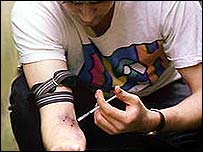By
Liz Highleyman
 The
advent of HIV epidemic in the early 1980s led to widespread
establishment of prevention programs for IDUs, including harm
reduction efforts such as needle exchanges. Prior studies have
shown that such efforts have significantly reduced HIV incidence
(new infections), but they have had less impact on hepatitis
C. In part this may be because HCV is much easier to transmit
than HIV and more likely
to spread through occasional risky behavior.
The
advent of HIV epidemic in the early 1980s led to widespread
establishment of prevention programs for IDUs, including harm
reduction efforts such as needle exchanges. Prior studies have
shown that such efforts have significantly reduced HIV incidence
(new infections), but they have had less impact on hepatitis
C. In part this may be because HCV is much easier to transmit
than HIV and more likely
to spread through occasional risky behavior.
Shruti
Mehta from Johns Hopkins Bloomberg School of Public Health and
colleagues characterized trends in incidence of HCV and HIV
infection among injection drug users (IDUs) in Baltimore recruited
during 4 periods: 1988-1989, 1994-1995, 1998, and 2005-2008.
The
researchers calculated incidence of both infections within the
first year of follow-up among 373 IDUs whose initial HCV test
results were negative, and 2061 IDUs who were HIV negative at
baseline.
Results
 |
The
average age of IDUs increased during the study (from 34
to 43 years), as did duration of drug use (from 13 to 19
years). |
 |
HIV
incidence declined significantly over time: |
| |
 |
1988-1989:
5.5 cases per 100 person-years (PY); |
 |
1994-1995:
2.0 cases per 100 PY; |
 |
1998:
0 cases per 100 PY; |
 |
2005-2008:
0 cases per 100 PY. |
|
 |
HCV
incidence declined somewhat, but remained relatively high;
the decrease did not reach statistical significance: |
| |
 |
1988-1989:
22.0 cases per 100 person-years (PY); |
 |
1994-1995:
17.2 cases per 100 PY; |
 |
1998:
17.9 cases per 100 PY; |
 |
2005-2008:
7.8 cases per 100 PY. |
|
 |
HCV prevalence (all cases, new plus existing) declined,
but mostly among younger IDUs. |
 |
Among
people younger than 39 years, HCV prevalence decreased significantly
relative to 1988-1989 (adjusted prevalence ratio [PR] 0.73
for the 2005-2008 cohort). |
 |
For
people age 39 or older, however, a decrease was observed
only for the 2005-2008 cohort (adjusted PR 0.87). |
Based
on these findings, the study authors wrote, "Although efforts
to reduce blood-borne infection incidence have had impact, this
work will need to be intensified for the most transmissible
viruses, such as HCV."
"Large-scale
expansion of [needle exchange programs] and opiate substitution
treatment programs appear to have reduced HIV transmission among
IDUs," they elaborated in their discussion. "In this
analysis, we also detected a decline in HCV infection incidence
as well as HCV infection prevalence among those who were younger
or had recently started injection. Importantly, we observed
that HCV acquisition may be delayed by up to 10 years among
IDUs compared with that in the late 1980s when the epidemic
was at peak."
"[A]dditional,
more intensive strategies, particularly those that target new
initiates into drug injection, are needed to significantly impact
community-level drug-related risk," they concluded.
In
an accompanying
editorial, Jason Grebeley and Gregory Dore from the University
of New South Wales in Sydney concurred that existing harm reduction
measures in most settings are inadequate.
"The development and implementation of national harm-reduction
strategies including broader coverage, enhanced early access,
and intensification and combination of interventions are probably
all needed," they recommended. "Furthermore, peer-based
education, support, and community participation will be essential
for the successful delivery and uptake of intervention strategies."
Investigator
affiliations; Department of Epidemiology, Johns Hopkins Bloomberg
School of Public Health and Department of Medicine, Johns Hopkins
School of Medicine, Baltimore, MD; Department of Medicine, University
of California San Diego School of Medicine, San Diego, CA; Center
for Urban Epidemiologic Studies, New York Academy of Medicine,
New York, NY.
2/11/11
References
SH
Mehta, J Astemborski, GD Kirk, and others. Changes in Blood-borne
Infection Risk Among Injection Drug Users. Journal of Infectious
Diseases 203(5): 587-594 (free
full text). March 2011.
J
Grebely and GJ Dore. Prevention of hepatitis C virus in injecting
drug users: a narrow window of opportunity. Journal of Infectious
Diseases 203(5): 571-574 (free
full text). March 2011.
Other
Source
Journal of Infectious Diseases. Study Finds Little
Decline in Hepatitis C Infections Among Injection Drug Users.
News release. January 31, 2011.
